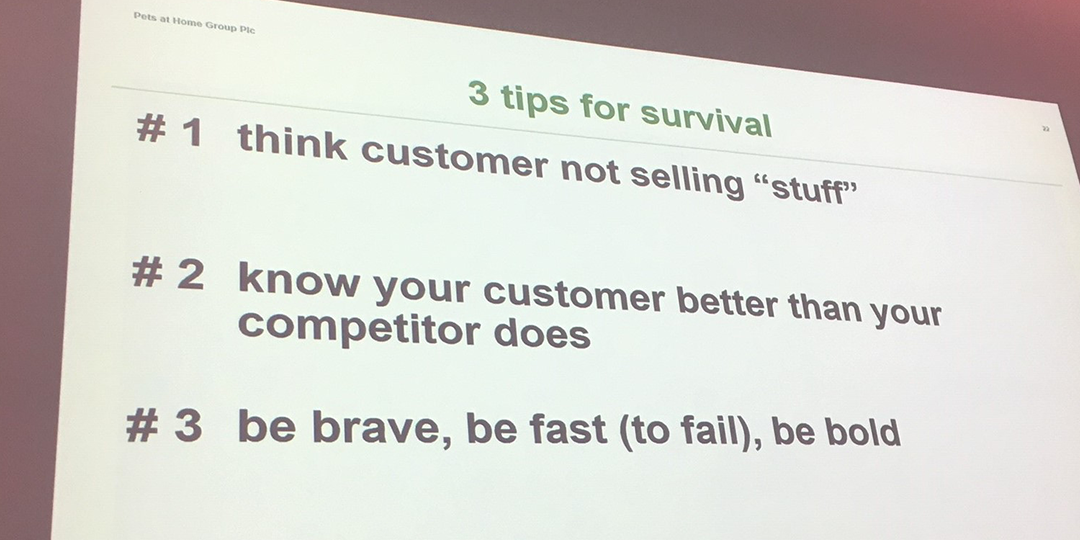It was a retail hivemind at The Cavendish Centre today, where retail executives gathered for the Omnichannel Futures event put on by Retail Bulletin to discuss (you guessed it) omnichannel retailing, trends, problems and solutions. A main point of today’s event: Retail used to be about selling stuff, now it’s about emotions. So, why are many retailers still selling stuff?
For Pets at Home, the business sold stuff for 25 years, and did it well. But once other retailers in the pet space started selling stuff too (and selling it cheaper and delivering it faster) Pets at Home lost market share, and fast. Sales fell, cost base rose. In the darkest days, shareholders in the business were actually betting on the failure of Pets at Home.
“Retailers are naturally optimistic,” says Peter Pritchard, Group CEO of Pets at Home. Often, they think that if they carry on as they have always done, it will eventually be ok. Peter says, it won’t. I agree with Peter.
Many an analyst has blamed external factors for the demise of our best loved high street brands, but the core of the matter is when a retailers’ purpose is not aligned to why customers use them. #fail.
When retailers compete on stuff alone, it becomes about price. And when it’s all about price, it’s a race to the bottom. Retailers such as Amazon or others will often beat on price. Why? Because Amazon doesn’t make a profit from its retail division. How do they make profit?? For retailers that sell stuff to make a profit (like most!), it’s important to ensure that the stuff isn’t just your focus. Many retailers say this, but few actually do it.
According to Mark Dunhill, former CEO of Whittard, in order to create loyalty, great retailing goes beyond a transactional relationship, it has to become an emotional one. A purpose that is meaningful ignites emotion in consumers.
So, how can high street retailers create an emotional relationship with their customers? Have a clear purpose that is about more than selling stuff and get the Board on board.
According to Andrew Mann, of North Bailey and former VP of Insight, Pricing & Digital CRM, M&S, the Board is key to ensuring that transformation is given the weight to succeed. Saying of a recent transformation project, “when the Board become clear on the problem, then they can more easily align on a solution.”
Retailers need to develop a purpose that the whole business aligns to first and foremost, before their individual departmental objectives. The purpose must ignite emotion in your customers. For retailers with stores, make your stores about experience rather than stuff. Then, develop services that help you:
- Create a reason for customers to go to the shop. Classes, workshops, entertainment, convenience.
- Create a reason to want to go to the shop. Fun, engagement, relationships. PEOPLE.
Pets at Home has created 20+ new format stores where the experience and services are the focus, including ‘wash your own dog’ stations, places to play with your pet, adoption zones and activities. It even has a deli for dogs! By freeing up staff time to serve, chat, and be kind instead of re-stocking product constantly, sales of product went up! You can see a lot of great photos on this website.
Every journey of transformation starts with a harsh reality to confront. If a retailer is brave enough to confront the stark reality, then they can begin on transformation. Peter Pritchard says retailers need to approach three uncomfortable truths:
-
- Why do we exist for customers?
- What capabilities make us special for customers?
- What do we need to change to be better for customers?
I think if retailers can face and find those truths and implement change, there may be hope for the high street yet.
Cybertill software enables experiential retailing by empowering retailers to offer a variety of shopping services, and integrate them seamlessly together. Learn more about Cybertill’s enterprise epos solution.

Rachel is Head of Marketing at Cybertill, driving lead generation and content marketing. She has a wealth of experience within retail, ecommerce, and web and UX design and is always looking out for new trends.

